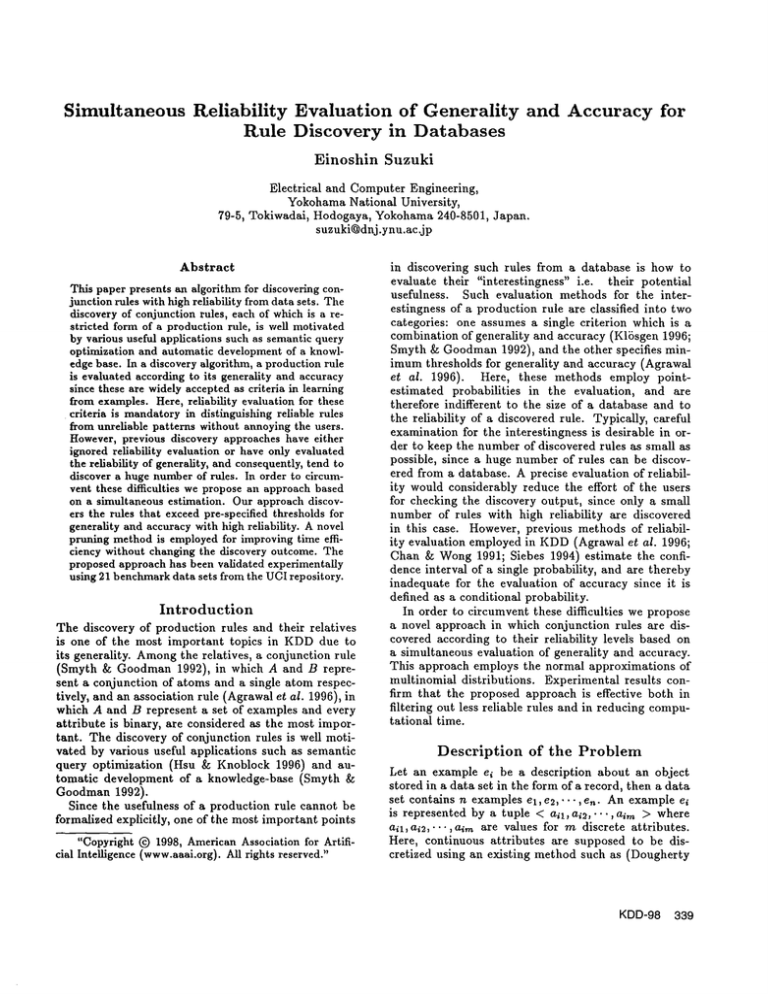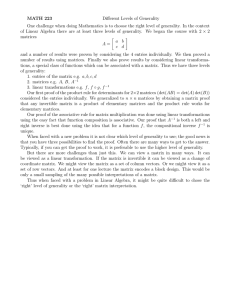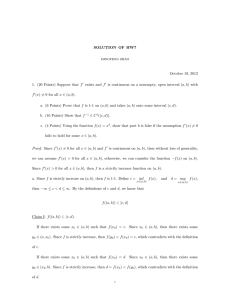
Simultaneous
Reliability
Evaluation
of Generality
Rule Discovery
in Databases
and Accuracy
for
Einoshin Suzuki
79-5,
Electrical
and Computer Engineering,
Yokohama National University,
Toldwadai, Hodogaya, Yokohama 240-8501,
suzuki@dnj.ynu.ac.jp
Abstract
This paper presents an algorithm for discovering conjunction rules with high reliability from data sets. The
discovery of conjunction rules, each of which is a restricted form of a production rule, is well motivated
by various useflll applications such as semantic query
optimization and automatic development of a knowledge base. In a discovery algorithm, a production rule
is evaluated according to its generality and accuracy
since these are widely accepted as criteria in learning
from examples. Here, reliability
evaluation for these
criteria is mandatory in distinguishing reliable rules
from unreliable patterns without annoying the users.
However, previous discovery approaches have either
ignored reliability
evaluation or have only evaluated
the reliability of generality, and consequently, tend to
discover a huge number of rules. In order to circumvent these difficulties
we propose an approach based
on a simultaneous estimation. Our approach discovers the rules that exceed pre-specified thresholds for
generality and accuracy with high reliability.
A novel
pruning method is employed for improving time efficiency without changing the discovery outcome. The
proposed approach has been validated experimentally
using 21 benchmarkdata sets from the UCI repository.
Introduction
The discovery of production rules and their relatives
is one of the most important topics in KDDdue to
its generality. Amongthe relatives,
a conjunction rule
(Smyth & Goodman 1992), in which A and B represent a conjunction of atoms and a single atom respectively, and an association rule (Agrawal et aI. 1996), in
which A and B represent a set of examples and every
attribute is binary, are considered as the most important. The discovery of conjunction rules is well motivated by various useful applications
such as semantic
query optimization
(Hsu ~ Knoblock 1996) and automatic development of a knowledge-base
(Smyth
Goodman 1992).
Since the usefulness of a production rule cannot be
formalized explicitly,
one of the most important points
"Copyright (~) 1998, American Association for Artificial Intelligence (www.aaai.org). All rights reserved."
Japan.
in discovering
such rules from a database is how to
evaluate their "interestingness"
i.e. their potential
usefulness.
Such evaluation
methods for the interestingness of a production rule are classified into two
categories:
one assumes a single criterion
which is a
combination of generality and accuracy (K15sgen 1996;
Smyth & Goodman 1992), and the other specifies
minimum thresholds for generality
and accuracy (Agrawal
et al. 1996). Here, these methods employ pointestimated probabilities
in the evaluation,
and are
therefore indifferent
to the size of a database and to
the reliability
of a discovered rule. Typically, careful
examination for the interestingness
is desirable in order to keep the number of discovered rules as small as
possible, since a huge number of rules can be discovered from a database. A precise evaluation of reliability would considerably reduce the effort of the users
for checking the discovery output, since only a small
number of rules with high reliability
are discovered
in this case. However, previous methods of reliability evaluation employed in KDD(Agrawal et al. 1996;
Chan& Wong 1991; Siebes 1994) estimate
the confidence interval of a single probability,
and are thereby
inadequate for the evaluation of accuracy since it is
defined as a conditional probability.
In order to circumvent these difficulties
we propose
a novel approach in which conjunction rules are discovered according to their reliability
levels based on
a simultaneous evaluation of generality and accuracy.
This approach employs the normal approximations
of
multinomial distributions.
Experimental results confirm that the proposed approach is effective
both in
filtering
out less reliable rules and in reducing computational time.
Description of the Problem
Let an example ei be a description
about an object
stored in a data set in the form of a record, then a data
set contains n examples el, e2,"-,en.
An example ei
is represented by a tuple < all, a~,...,
aim > where
ail,ai2,’",o4m
are values for m discrete attributes.
Here, continuous attributes
are supposed to be discretized using an existing method such as (Dougherty
KDD-98 339
et al. 1995; Fayyad gz Irani 1993). An event representing, in propositional form, a single value assignment to
an attribute will be called an atom.
A conjunction rule (Smyth & Goodman1992) r(#)
is a production rule which represents a probabilistic
correlation or causality between its premise and conclusion, and is represented by
r(p) = A~, -~ c,
At‘ = alAa2A.’.Aa~,
(1)
(2)
where at and c are single atoms. In this paper, we
consider the problem of finding a set of conjunction
rules from a data set.
In learning from examples, generality and accuracy
are considered as the most general criteria for evaluating the goodness of a hypothesis. In case of a conjunction rule At‘ --4 c, these two criteria correspond
to
) the point-estimated probabilities/3(A~) and t3(c[At,
respectively (Smyth & Goodman1992).
t~xisting methods for evaluating the generality and
the accuracy of a production rule can be classified into
two approaches: the single expression approach such
as (K16sgen 1996; Smyth & Goodman 1992) which
assumes a single criterion defined by a combination
of two criteria,
and the simultaneous approach such
as (Agrawal et al. 1996) which specifies a minimum
threshold for each criterion.
Besides, several methodshave been proposed to evaluate the reliability of generality (Agrawalet al. 1996;
Chan 8z Wong1991; Siebes 1994), which estimate the
true probability p(Ag) of the premise. These methods
can be employed for a modified version of the simultaneous approach: specify a minimumthreshold for
p(Ag) with some confidence level and another minimumthreshold for ~(clA~, ). Note that a smaller number of rules are discovered in this modified version
since the lower-bound of the true probability p(Au)
is smaller titan/~(A/,).
Wetake the simultaneous approach due to its generality, and for a more detailed evaluation of a rule,
consider both the reliability of its generality and the
reliability of its accuracy. Wediscover the rules v(/z)
which true probabilities p(Ag) and p(c]A~,) are greater
than or equal to their respective minimumthresholds
Os, 0~, with a confidencelevel 1 - ~.
Pr{p(At‘) >_ 0s, p(c[At‘) >_ OF}___ 1 --~i. (3)
Evaluation
of Reliability
Previous
Methods
In KDD,the Chernoff bound is frequently used in assessing the reliability of a discovered production rule
(Agrawal et al. 1996; Siebes 1994). Consider the problem of estimating the true probability p of an atom
from a data set. Let the probability obtained by point
estimation be/3, and ln(x) be the natural logarithm
x. Then according to the theorenh the 1-d confidence
340 Suzuki
interval for the probability p is given as follows (Siebes
1994).
-
~ln
<p<__p+ ~ln .
(4)
This problem, however, can be also resolved by the
normal approximations of the binomial distributions.
Let a~ satisfy
-~Tr
(%
exp
a6
d~ = 1 - ~.
(5)
Then the confidence interval is given by
Note that (4) and (6) are for estimating a single
probability. Therefore, neither (4) nor (6) are
quate for our problem since (3) contains a conditional
probability.
Normal Approximations
of the
Multinomial
Distributions
The above discussions suggest that we should estimate
the confidenceregion of the probabilities related to (3).
This paper employs the normal approximations of the
multinonfial distributions. First,, atoms D1, D2, D3are
defined as follows.
D1 -= cA At,
(7)
,
D2 --- ~AA~,,
(8)
D3 --= A
(9)
u.
Since the case 3 i ib(Di) = 0 is easily handled by the
normal approximations of the binomial distributions,
we first showthe results for the case V i /5(Di) ¢
From (7) --~ (9), the events D1, D2, D3 are mutually
exclusive and exhaustive, hence we can assume that
their respective numbers of oeeurrenee (xl, x~., x3)
are multinonfially distributed. Let (ul, u2, u3) be the
respective numbers of the examples (xx, ~2,x3) in the
data set, and
~
U2)
’ (Ul,
(10)
£ ~ (zl,z~.).
(11)
Assuming that n is enough large, the above multinomial distribution is approximated by a 2-dimensional
normal distribution, of which probability density function is given by
1
f(~) -- 2rriUll/2
{ t(~exp
g)H-t(~72
g)
.
(12)
Here, H and H-~ represent the covariance matrix and
its inverse matrix given by (13) and (14) respectively,
and tG is the transposed matrix of a matrix G.
H = -1(ut(n--ut)
-u,u~
n
--utu2
u2(n
- u~) )
(13)
H_l
=
n - Ul1("-’*’1)
- u2
,.1
1
n-u~
Consider a region covered by an ellipse
V~: ’(~- g)H-l(~ - g)< f12
(14)
(15)
which satisfy
(16)
Pr(~" E V6) = 1 -
This ellipse Va corresponds to the 1 - 5 confidence region of £, and f16 can be calculated by numerical integration. From (14) and (15), ~ is given as follows.
1 {_~1u2
n -- Ul
(,=
(
gl
--
Ul)
2
n-ul
q-
-- U2
A depth-first search method is employed to traverse
this tree, and the maximumvalue M of tt is given
by the user. To alleviate the inevitable inefficiency of
depth-first search, we employ the following theorem.
Based on the theorem, the nodes which satisfy at least
one of the stopping criteria (23) and (24) are not
panded without altering the algorithm’s output.
Theorem1 Let the rule of the current node be r(#’).
If the rule r(#’) satisfies either (23) or (24), no rules
r(/z) of the descendant nodes satisfy both gl) and (22).
o
1-pay n/3(A.,)
J/3(A"’)
-
<
(17)
From(7) --. (9), (3) represents a problem of judging
whether (18) and (19) always hold in (17).
zl + x2
n
Xl
xl + x~
> es
(18)
_> OF.
(19)
Since an expression on the left hand side in (18) or (19)
being a constant represents a line, the maximumand
the minimumof each expression occur at the extremes
of the ellipse. Let A be an undetermined multiplier,
then according to the Lagrange’s multiplier method,
an extremum of an expression f under g = 0 satisfy
Let g be the ellipse in (17), and fl and f= be the expression on the left hand side in (18) and (19) respectively.
Appling (20) for f = fl and f = f2, we obtain
15(A.)~
1-f~6v__/1-~-~(--~)
) iSCA.) >_
1-
+
(21)
(clA.) _>0F. (22)
Similarly, we can show that (21) and (22) also hold
3 i ~(Di) = 0. Therefore, we obtain a set of conjunction rules each of which satisfies (21) and (22).
Discovery
(23)
--
U2
- + -
< 8s,
Algorithm
In our algorithm, a discovery task is viewed as a search
problem, in which a node of a search tree represents a
conjunction rule r(/z). Let tt : 0 represents the state
in which the premise of a rule r(tt) contains no atoms,
then we define that tt = 0 holds in a node of depth 1,
and as the depth increases by 1, an atom is added to
the premise.
(1 - fl,¢1-
~5(A"’)
j
ese
<
(24)
Proof Assume a rule r(/z) of a descendant node
satisfies
both (21) and (22). First,
function
(1 -/3zX/(1 - *)1,~1.) increases monotonically from
n, fl~ > 0. Then, contradictions can be derived from
(21), (22),/5(A~,) >_ iS(Aa) [9(c, Au,) >_ ~(c,A~). []
In rule discovery, we often discover similar rules
Au -4 c and A{ --4 c, where A~. is a specialization
of Au. For an easy interpretatmn of the results, such
! --+ c is not outputted if i6(c[A~) </5(c[Au).
a rule Au
Application
to Data Sets
The proposed method was tested with data sets from
several domains, including 21 benchmark data sets
(Merz et al. 1996) in the machine learning community.
We have compared our method with the previous
methods, where the parameters were set to M= 3, 5 --0.05, 9s = 0.1 and 8F = 0.9. In the experiments, a continuous attribute is discretized in advance by (Fayyad
& Irani 1993). Figure 1 shows the ratio of the number
of discovered rules between the three approaches and
the approach without reliability
evaluation. A bullet
(.), a times (x) and a triangle (A) correspond
approach, the approach based on the Chernoff bound
and the approach based on the normal approximations
of the binomial distributions respectively. In the figure,
a bar chart represents the number of rules discovered
by the approach without reliability evaluation in a logarithmic scale, and data sets, which are shown along
the horizontal axe, are sorted with respect to these
numbers.
From figure 1, we note that the proposed approach
reduces a considerable number of rules in many data
sets compared with the previous approaches. In the
"german" data set, for example, it reduces 88% and
81% of the rules compared with the approach based
on the normal approximations of the binomial distributions and with the approach based on the Chernoff
bound respectively. Since 2,352 rules are discovered by
KDD-98 341
the no evaluation approach from this data set, the proposed methodis effective in reducing the user’s effort
of verifying the discovered rules. Sameconclusion can
be obtained from the experiments with the "satellite"
data set, in which the proposed method reduces more
than 51,128 rules compared with the other methods.
The proposed method, since it evaluates more information than the other methods, reduces a larger number of rules or at least the same number of rules. It
reduces only a small fraction of rules in the "nursery"
and "shuttle" data set, the reason of which is difficult
to be explained since it concerns the distribution of
the attribute values in the data sets. A simple explanation is that these data sets have a small number of
rules with low reliability to be reduced since the numbers of attributes are relatively small (at most 10) and
the numbers of examples are large (at least 12,960).
However, such a data set, which has a large number
of examples and a small number of attributes and attribute values, is considered to be rare in KDD.
In the three algorithms presented in the previous experiments, discovery is regarded as a search problem,
and its execution time is knownto be approximately
propositional to the number of searched nodes. Figure
2 shows the ratio of the number of searched nodes between the three approaches and the approach without
reliability evaluation. To be fair, we have derived stopping criteria which correspond to theorem 1 for every
method, and have employed them in the experiments.
From figure 2, we note that the proposed approach
reduces a considerable number of nodes in many data
sets compared with the previous approaches. In the
"satellite" data set, for example, it reduces 80%and
77% of the nodes compared with the approach based
on the normal approximations of the binomial distributions and with the approach based on the Chernoff
bound respectively.
The proposed method, since it
evaluates more information than the other methods,
reduces a larger number of nodes or at least the same
number of nodes. The effectiveness of the approach,
however,is difficult to be analyzed since it relates complicatedly with the probability distribution of the attribute values in the data set.
From the above experiments, the proposed approach
is superior to or at least as effective as the existing approaches in terms of filtering out less reliable rules and
pruning the searched nodes. We can safely conclude
that our approach reduces both the user’s effort and
the computational time, and is therefore mandatory
for the efficient discoveryof reliable rules.
Conclusion
This paper has described an approach based on a
stochastic estimation for discovering rules with high
reliability.
The previous approaches, since they have
neglected reliability evaluation or have only evaluated
the reliability of generality, had problemsof discovering
a huge number of unnecessary rules, causing a consid342 Suzuki
erable overload to their users. Our approach remedies
this problem by a simultaneous estimation of the confidence region based on the normal approximations of
the multinomial distribution.
Consequently, our approach filters out rules with low reliability by evaluating both the reliability of generality and the reliability
of accuracy. Moreover, we have derived stopping criteria to improve search efficiency without altering the
discovery results.
The proposed approach has been applied to 21 data
sets from the UCI repository (Merz et al. 1996). Experimental results show that our approach reduces
both the number of discovered rules and the number of
searched nodes compared with the existing approaches.
The proposed approach is especially effective in reliable
rule discovery in databases with a large number of attributes and attribute values. Moreover, it would be
also effective when the computational time is limited
due to its use of newly-derived stopping criteria.
References
Agrawal, R., Mannila, H., Srikant, R., et al.
1996. Fast Discovery of Association Rules, Advances
in Knowledge Discovery and Data Mining, AAAI
Press/The MITPress, pp. 307-328.
Chan, K. C. C. and Wont, A. K. C. 1991. A Statistical
Technique for Extracting Classificatory Knowledge
from Databases, Knowledge Discovery in Databases,
AAAIPress/The MIT Press, pp. 107-123.
Dougherty, J., Kohavi, R. and Sahami, M. 1995. Supervised and Unsupervised Discretization of Continuous Features, Proc. of ICML-95, pp. 194-202.
Fayyad, U. M. and Irani, K. B. 1993. Multi-Interval
Discretization of Continuous-Valued Attributes for
Classification Learning, Proc. of IJCAI-93, pp. 10221027.
Hsu, C. and Knoblock, C. A. 1996. Using Inductive
Learning to Generate Rules for Semantic Query Optimization, Advances in Knowledge Discovery and Data
Mining, AAAIPress/The MIT Press, pp. 425-445.
K15sgen, W. 1996. Explora: A Multipattern and Multistrategy Discovery Approach, Advances in Knowledge Discovery and Data Mining, AAAIPress/ The
MITPress, pp. 249-271.
Merz, C. J. and Murphy, P. M. 1994. UCI Repository
of machine learning databases, http://www.ics.uci.
edu/"mlearn/MLRepository, html, Univ. of California, Dept. of Information and Computer Sci.
Siebes, A. 1994. Homogeneous Discoveries Contain No Surprises: Inferring Risk-profiles from Large
Databases, AAAI-94 Workshop on Knowledge Discovery in Databases, pp. 97-107.
Smyth, P. and Goodman, R. M. 1992. An Information Theoretic Approach to Rule Induction from
Databases, IEEE Trans. on Knowledge and Data
Eng., 4 (4), pp. 301-316.
Figure 1: Performance of the 3 methods with respect
graphs, and the right scale is for bar charts.
The left
/:I\ i~’ /i "’X’~X.~/:’.’CBhi urn~ff ~\~," i¢~il/2~"i,.’’x"~K;.:’"’-:~l
0.8
’,,"
¯ .".
’,. "- .~ .; ’c-:::~:
"k/ ’= ?
<2
........... ...........
....... t-Y:.",\/l
.............~::::::;.
" "
I t/ ’.~ I ..........~-~
".. f"
-.. .L.i.::....:.:~
..................................
....:]~
, ~. / _
0.7
¯~/I
:/::::::I~,,
~/:::~~
g
o 0.6
:,
4,~
4.0
3.5
3.0
0,4
2.5
g
o
2.0
"~ 0.3
0
is for line
5.5
0.5
¯ ~ 0.2
’S
o.1
scale
[:::~.,,
...........
¢_.-::-~::7.:.~ .~.....................................
::... 5.0 o
..........
/~.........................
0.9
cx,
._g
rules.
normalapproximations
of the binominal
distributions
1.0
i
to the number of discovered
II
:II:I
I:I,
’.........
1.5
~-ff
,...1
1.0
~ ....
IH1111
....
II
....
I-
Figure 2: Performance of the 3 methods with respect
graphs, and the right scale is for bar charts.
0.5
go the number of searched nodes. The lefg scale
is for line
normalapproximations
of the binominal
distributions
8.0
,.o
..............................................
~::
...................
;..,.~
..................
~.[
..........................
i "~.:,,
//. ’~
,
,,
/:.:""v~.
/.~:.--~.--~--:.-.~,
~.:....................
~"’" 7.5
0.9..................J’Z
..........
);r’""
x,~.~:
.........
FX:’"’"/
..............
:’~:=’5"-’"]~"
"""""t.~.............
/
i.."-\ i "x
""-"" I~ ".’\
~"
-/
x.................................
:~....../z
.............
.’.................................. 7.0
ii...:’X-.../
.........
I...~
.......
0.8................#:"
",),6
/
\
",3,//
Chemoff
"~:
~
t
",#!
~:
........Bound
¯ ...........
I 1......... "~:.
¯
6.5
0.7 ¯ , ,"
\-\
6.0
0.6
--,
.....
":"
..................................................
I\
__ __
i
.~
i
g
i
5.5
i
0.5
......................................................................................
.jlq___._~___
l ’
proposed .-_
!
.................. method
......./-.----~--.......~-I..IL.’.,.
-i
5.0 !
0.4
I--I
.....................
03
.........
~-~ ......
~/r7
~]~
o .....
o.~
’
i ~
~’~
4.5
! ~"
4.0
d3
3.5
3.0
o
.,=
~ ~ i
£
-=
I I ~ -~>
....o ..~ ~ ~
~ .~
.i = :’~
~
~ ~
.-I I !
£
KDD-98 343





